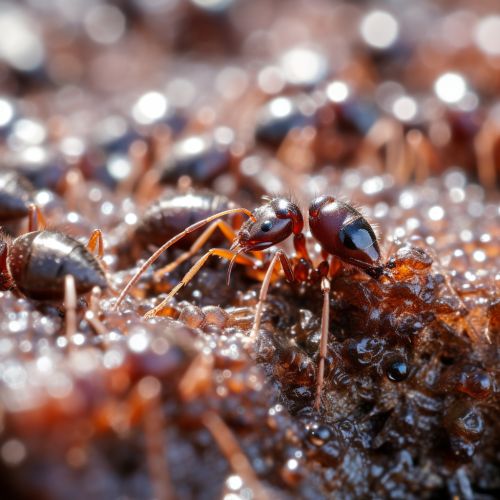Recognition pheromones
Introduction
Recognition pheromones are a type of chemical signal that play an essential role in the identification and recognition of individuals within a species. These chemical compounds are secreted by an organism and detected by another member of the same species, leading to a specific behavioral response. Recognition pheromones are particularly prevalent in social insects, such as ants, bees, and termites, but they are also found in a variety of other animals, including mammals.


Biological Role and Function
Recognition pheromones serve a critical role in the social structure and survival of many species. They are used for a variety of purposes, including mate recognition, kin recognition, and colony recognition in social insects. These pheromones are typically secreted from specialized glands and can be detected by the olfactory systems of other individuals.
Mate Recognition
In many species, recognition pheromones are used to identify potential mates. For example, in many insects, males will release specific pheromones that are detected by females of the same species. These pheromones signal the male's availability and suitability as a mate. Similarly, in some mammalian species, females release pheromones during estrus that signal their fertility to males.
Kin Recognition
Recognition pheromones also play a crucial role in kin recognition, which is the ability of an organism to distinguish between relatives and non-relatives. This is particularly important in species that display kin-selected behaviors, such as altruism or nepotism. For example, in many social insect colonies, workers use recognition pheromones to identify and preferentially care for their siblings.
Colony Recognition
In social insects, recognition pheromones are vital for maintaining the integrity of the colony. Each colony has a unique blend of pheromones that its members recognize. This "colony odor" helps insects distinguish nestmates from intruders. If an intruder enters the colony, it will not have the correct colony odor and will be attacked or expelled.
Chemical Composition and Detection
Recognition pheromones are typically composed of complex mixtures of chemical compounds, including hydrocarbons, alcohols, aldehydes, and esters. The exact composition of these pheromones varies widely between species and even between individuals within a species.
These pheromones are detected by the olfactory system of the receiving individual. In insects, this typically involves the antennae, which contain specialized sensory neurons that can detect specific pheromone molecules. In mammals, recognition pheromones are often detected by the vomeronasal organ, a specialized part of the olfactory system that is particularly sensitive to pheromones.
Research and Applications
Recognition pheromones have been the subject of extensive research due to their importance in animal behavior and their potential applications. For example, understanding the chemical composition and function of these pheromones could lead to the development of new methods for pest control. By disrupting the recognition pheromones of pest species, it may be possible to confuse or disorient these pests and prevent them from breeding or forming colonies.
In addition, recognition pheromones could have potential applications in conservation biology. For example, they could be used to encourage endangered species to breed or to prevent invasive species from establishing colonies.
